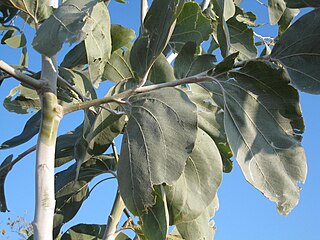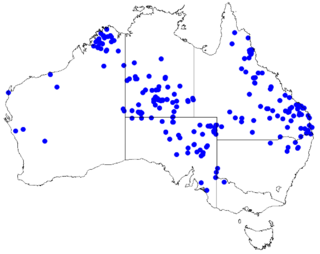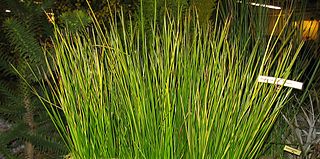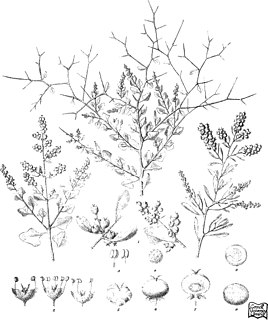
Dichopogon strictus, commonly known as chocolate lily, is a herbaceous perennial plant species native to Australia.

Thysanotus is a genus of perennial herbs in the family Asparagaceae, subfamily Lomandroideae. They are mostly native to Australia with 45 of the 50 known species occurring in Western Australia alone, although a few species range northward into New Guinea and Southeast Asia as far north as southern China.

Alphitonia excelsa, commonly known as the red ash or soap tree, is a species of tree in the family Rhamnaceae. It is endemic to Australia, being found in New South Wales, Queensland, Northern Territory and the northeastern tip of Western Australia. It is used in bush regeneration as a pioneer species and for amenity planting.

Suaeda australis, the austral seablite, is a species of plant in the family Amaranthaceae, native to Australia. It grows to between 0.1 and 0.9 metres in height, with a spreading habit and branching occurring from the base. The leaves are up to 40 mm in length and are succulent, linear and flattened. They are light green to purplish-red in colour.
Pimelea microcephala is a dioecious shrub in the family Thymelaeaceae, native to Australia. It grows up to 4 metres high and produces greenish-yellow flowerheads. The male flowerheads have 13 to 100 flowers while the female flowerheads have 7 to 12. The leaves are 7 to 40 mm long and 1 to 4 mm wide.

Pimelea humilis, also known as common riceflower or dwarf riceflower, is a shrub in the family Thymelaeaceae, native to Australia. It grows up to 0.5 metres in height. Flowerheads have 12 to 52 whitish flowers that are either female or bisexual. The leaves are 5 to 15 mm long and 2 to 8 mm wide.

Scaevola aemula, the fairy fan-flower or common fan-flower, is a small shrub in the family Goodeniaceae, native to southern Australia. It grows to 50 cm in height and produces white or blue flowers in spikes up to 24 cm long from August to March in its native range. These are followed by rounded, wrinkled drupes to 4.5 mm in length. It can also be found in Western Australia, South Australia, Victoria and New South Wales.

Jacksonia scoparia, commonly known as dogwood, is a native species of a pea-flowered, greyish, leafless, broom-like shrub or small tree that occurs in the south east of Queensland, Australia and eastern New South Wales.

Melichrus urceolatus, commonly known as urn heath or honey-gland heath, is a species of flowering plants in the family Ericaceae. The species is native to Queensland, New South Wales and Victoria in Australia. It is an erect shrub that grows to between 0.2 and 1.5 metres in height. The white, cream or yellow-green flowers, are clustered toward the branch bases and appear between March and November in the species' native range.

Brachyloma daphnoides, commonly known as daphne heath, is a small shrub in the family Ericaceae. The species has an upright habit, growing to between 0.4 and 1.5 metres in height. The leaves are 4 to 15 millimetres long and 1.7 to 3.6 millimetres wide. These are glossy green above and paler underneath. White flowers appear in the leaf axils between August and December in the species native range. These are tubular with a wider base. The rounded fruits are about 4 mm in diameter and are green or yellow brown. The species occurs in heath, woodland and forest in South Australia, Victoria, New South Wales and Queensland. It was first described by James Edward Smith, before being given its current binomial name by George Bentham in 1868.

Epacris microphylla , commonly known as coral heath, is a plant in the heath family Ericaceae and which is endemic to eastern Australia. It is a common, wiry shrub with tiny leaves that are often obscured by the flowers, especially near the ends of the stems. The plant sometimes grows in dense groups, giving the effect of a snowfall.

Grevillea ramosissima, commonly known as fan grevillea, is a shrub species of the family Proteaceae. It is native to south-eastern Australia.

The National Herbarium of New South Wales was established in 1853. The Herbarium has a collection of more than 1.4 million plant specimens, making it the second largest collection of pressed, dried plant specimens in Australia, including scientific and historically significant collections and samples of Australian flora gathered by Joseph Banks and Daniel Solander during the voyage of HMS Endeavour in 1770.

Persoonia terminalis, also known as the Torrington geebung, is a shrub belonging to the family Proteaceae, and native to northern New South Wales and southern Queensland in eastern Australia. Reported as a subspecies of Persoonia nutans in 1981, it was described as a species by Lawrie Johnson and his colleague Peter Weston in 1991.

Hakea lissosperma, commonly known as needle bush and mountain needlewood, is a species of Hakea native to parts of south eastern Australia.

Acacia dunnii, commonly known as elephant ear wattle or Dunn's wattle, is a shrub or tree of the genus Acacia and the subgenus Plurinerves.

Wahlenbergia queenslandica is a small herbaceous plant in the family Campanulaceae native to Western Australia, to New South Wales, Queensland, the Northern Territory, and South Australia.

Machaerina rubiginosa, commonly known as soft twig rush, flat leaf twig rush or common twig rush, is a flowering plant in the sedge family, Cyperaceae, that is native to Asia and the Pacific.

Cyperus vaginatus, commonly known as stiff-leaf sedge or stiff flat-sedge, is a sedge of the family Cyperaceae that is native to Australia.

Chenopodium spinescens is a species of plant in the family Amaranthaceae, endemic to Australia. It is found in all states and territories of Australia with the exception of Tasmania.


















